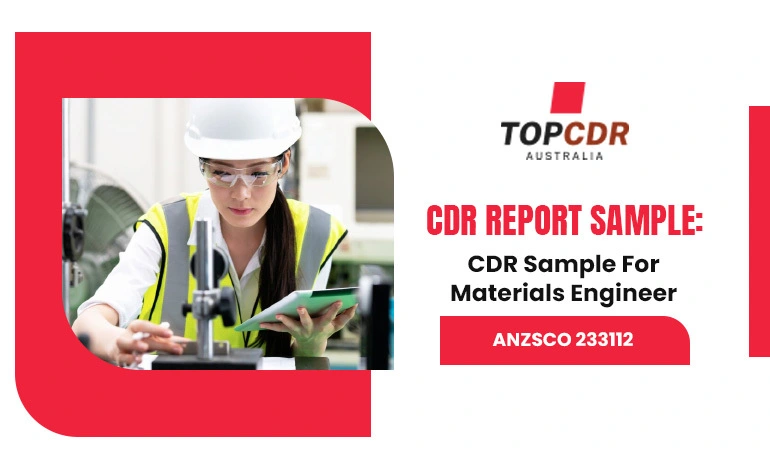CDR Sample For Materials Engineer
CDR Report Samples Approved By Engineers Australia
Download the free CDR report samples written by our professional experts according to the Migration Skill Assessment guidelines.
Materials Engineer ANZSCO 233112
CDR Sample for Materials Engineer

CDR Sample: Materials Engineer ANZSCO Code: 233112
The CDR Sample for Materials Engineers includes all the necessary reports, such as Three Career Episodes, Continuing Professional Development Writing, and a Curriculum Vitae Summary Statement. The Content of the CDR Report Sample is as follows:
- Curriculum Vitae: Resume based on a professional template.
- Continuing Professional Development Sample: The CPD Sample clearly explains the author’s engineering knowledge (1000 words.)
- Materials Engineer Career Episode Sample 1: “Study of Electrochemical Reduction of Titanium Dioxide (TiO2) for the extraction of Titanium”- (2100 words).
- Materials Engineer Career Episode Sample 2: “Production of Nanoparticles and study of their Magnetic Properties” (1890 words).
- Materials Engineer Career Episode Sample 3: “Fabrication and Analysis of Al 2219-Si Metal Matrix Composite (2300 words).
- Materials Engineer Summary Statement Sample: A detailed explanation of all the competency elements (3200 words).
The CDR Sample for Materials Engineers incorporates all the required reports, such as a Resume or Curriculum vitae (CV), Continuing Professional Development(CPD), 3 Career Episodes(CE), and a Summary Statement. The CDR Report Samples contain the following contents:
Resume:
Continuing Professional Development (CPDs)
Career Episodes:
Materials Engineer Career Episode Report: Sample 1
Project Name: “Study of Electrochemical Reduction of Titanium Dioxide (TiO2) for the extraction of Titanium“
In his first career episode, the author describes the project he did when he was pursuing an undergraduate degree in Bachelor of Metallurgical Engineering in his final year. The project’s name was “Study of Electrochemical Reduction of Titanium Dioxide (TiO2) for the extraction of Titanium”. The responsibilities of the author were:
To study the physical and chemical properties of Titanium
To research on the various methods of the reduction process of Titanium
To set up the experimental scheme for conducting the electrochemical reduction of TiO2
To research on the process of extraction of Titanium by electrochemical reduction of Titanium Dioxide being followed in DMRL
To continuously monitor the critical parameters during the experiments
To calculate the material balance for the production of 1Kg of Titanium
To calculate the theoretical DC requirement for the production of 1Kg of Titanium
Materials Engineer Career Episode Report: Sample 2
Project Name: “Production of Nano particles and study of their magnetic properties”
In second Career Episode, the author explains the engineering skills he used in the project he was involved in for the completion of his undergraduate degree in Metallurgical Engineering. His duties and responsibilities in the project “Production of Nano particles and study of their magnetic properties” were:
To study about different synthesis process of nano particles and select a feasible one among them
To perform chemical synthesis of nano particles using thermal decomposition method
To determine the phases of nano particles using XRD instrument
To perform Scanning electron microscopy, SEM experiment to determine size of Nano particles
To determine magnetic properties of synthesized nanoparticles using Vibrating sample magnetometer, (VSM) method
To perform energy dispersive X-ray spectroscopy (EDX) experiment to decide the composition and purity of the Nanomaterials
Materials Engineer Career Episode Report: Sample 3
Project Name: “Fabrication and Analysis of Al 2219-Si Metal Matrix Composite”
In the third Career Episode, the author demonstrates the technical skills he used to complete the project he was involved in as an assignment project during his bachelor’s degree in Metallurgical engineering. The Project was “Fabrication and Analysis of Al 2219-Si Metal Matrix Composite”. The Key responsibilities of the writer were:

 Chat with us
Chat with us